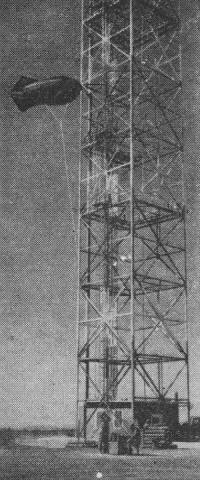|
September 1956 Popular Electronics
 Table of Contents Table of Contents
Wax nostalgic about and learn from the history of early electronics. See articles
from
Popular Electronics,
published October 1954 - April 1985. All copyrights are hereby acknowledged.
|
Early investigations
into RF signal atmospheric "ducting"
was reported in this 1956-era article in Popular Electronics. Ducting effects
were first noticed during World War II when Nazi broadcasts from occupied Paris
were received occasionally in London. Scientists discovered that a small change
in the humidity of the air near the surface has the effect of trapping radio waves,
a trapping process dubbed "ducting." These waves are conducted as if they were inside
of a metallic waveguide. Research by the U.S. Army Signal Corps determined a sudden
temperature rise at around 50 to 200 feet above the surface appears to have the
strongest effect.
Army Studies Radio Wave Curvature
 Weather tests are being conducted by Army
to analyze effects of temperature and humidity changes on microwave transmissions.
At left, members of meteorological team prepare "Kytoon" - a helium-filled nylon-covered
balloon - for ascent. Weather tests are being conducted by Army
to analyze effects of temperature and humidity changes on microwave transmissions.
At left, members of meteorological team prepare "Kytoon" - a helium-filled nylon-covered
balloon - for ascent.

"Kytoon," carrying a "Wiresonde" which records temperature and
humidity, rises in front of 200' tower containing electronic equipment used to measure
air conditions. This weather balloon can go as high as 1500 feet.

Wind direction, velocity and humidity are checked on instruments
located in base of tower. Testing takes place at Gila Bend, Arizona.
The Army Signal Corps is carefully watching weather effects on microwaves with
an eye towards "seeing" beyond the horizon. Normally, microwaves - used by, u.h.f.
TV stations - can only travel from transmitting points to the horizon, or within
line of sight. However, certain types of weather conditions trap these radio waves
and curve ,them around the horizon.
Personnel of the Aviation and Meteorological Dept., Army Electronic Proving Ground,
Fort Huachuca, Arizona, are interested in determining the exact constitution of
these unusual conditions. Electronic measuring instruments have been developed that
will detect minute changes in the temperature and humidity of surrounding air.
Scientists have discovered that a small change in the humidity of the air near
the surface has the effect of trapping the radio wave. Microwaves caught by trapping
are said to be "ducted" - or passed along as if they were inside of a metallic wave
guide. A sudden temperature rise some 50 to 200 feet above the surface appears to
have the strongest effect.
The Signal Corps needs to know the extent of these effects to judge whether or
not microwave transmissions can be intercepted by an enemy. During World War II
ducting was suspected when TV pictures from the Nazi-held transmitter in Paris could
be seen across the English Channel - to the military advantage of the British.
Posted October 8, 2020
(updated from original post on 3/13/2015)
|































